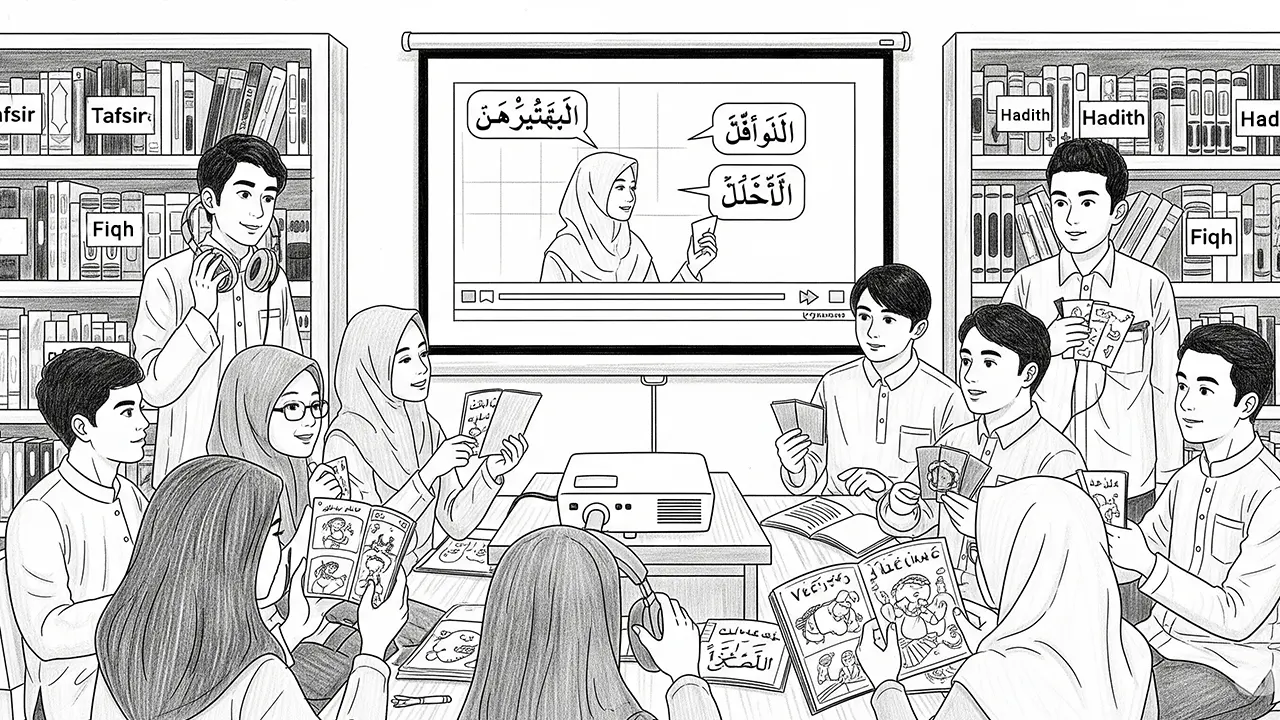In Indonesia, both public and private formal schools as well as Islamic residential schools offer Arabic instruction. Students must take Arabic as a subject for the national madrasah final exam. The primary goal of studying Arabic is to enhance one’s ability to communicate in the language and satisfy social communication demands.
Despite being a simple language, Arabic is hard for many pupils to learn. In order to prevent pupils from feeling overburdened, suitable learning practices are therefore required. A learning strategy is a plan that makes use of rules, methods, and resources to accomplish learning goals during the teaching and learning process. Increasing the effectiveness and efficiency of pupils’ information absorption is the primary objective.
It is important to take into account the language proficiency that students hope to attain while selecting an Arabic learning approach. Student boredom and a lack of excitement for learning can result from repetitious or passive teaching methods, which makes it challenging to meet learning goals.
Therefore, learning strategies are crucial for achieving objectives and need to be developed with a number of considerations in mind, such as the language skills being taught, the classroom setting, the students, and other elements of the teaching and learning process.
Since language is utilized in all human endeavors, it plays a significant role in human existence. Even in their dreams, people continue to utilize language. One of the most important aspects of reciprocal communication between people is language.
Ahmad Madkur asserts that spoken language, not written language, is the fundamental medium of human interaction and communication, and that the advent of spoken language signified the dawn of human civilization and history.
Arabic is a Semitic language that is spoken by people in the lowlands of Syria, the Arabian Peninsula, and the regions surrounding the Tigris and Euphrates Rivers. One of the Semitic languages most often spoken worldwide is Arabic.
Because Arabic is so important in today’s globe, especially in Indonesia, where the majority of people are Muslims, many people are interested in learning it It is a language that is studied extensively all around the world.
Aside from religion, which encompasses hadith, fiqh, tafsir, tauhid, and other disciplines, Arabic is also utilized in political science, economics, and history. Speaking Arabic, more than one billion Muslims around the world use it as their primary language of worship.
Learning Arabic is meant to help students become proficient speakers and communicators. stated that the primary objective of studying Arabic for non-native speakers is to increase one’s capacity for accurate self-expression and fluent speech.
Speaking Arabic is a barrier to studying in madrasas and other institutions, making it challenging for students to meet learning objectives. A supportive language environment is necessary to overcome this, as is practice and habituation both within and outside of the classroom.
It is possible to incorporate both visual and aural cues into the linguistic environment through discussion, television viewing, newspaper reading, and classroom activities. Islamic universities have an important role in promoting Islamic scholarship, particularly by assisting their students in becoming more proficient in Arabic so they can more effectively study Arabic literature.
In actuality, though, many Islamic university graduates struggle with fluency in Arabic. This is affected by a number of internal and external factors. In order to facilitate this learning process, some universities are experimenting with setting up spaces where Arabic is spoken.
The three tasks of a language instructor are to develop linguistic competence, personal competence, and communicative competence. One of the most significant functions of language is communication.
The personal function is one of the seven language functions that enables people to express their emotions, sentiments, and emotional responses. The usage of this unique language function should therefore be promoted in language instruction as well.
Effective Learning Strategies
The selection of Arabic language learning methods must take into account the language skills that students want to achieve:
- To keep pupils from feeling overburdened, appropriate learning practices are required.
- Students may become disinterested and lose interest in learning if they are exposed to repetitious or passive strategies.
- Methods like al-sam’iyah al-syafawiyah (audio-lingual technique), the qira’ah (reading) method, and the direct method have all proven effective in assisting pupils in developing their receptive skills (reading and listening), which are critical for language acquisition.
- The Role of Islamic Universities Given the significance of Arabic in the study of Islamic sciences, Islamic universities have a strong responsibility to raise student and academic proficiency in the language.
- The Need for Innovative Learning Strategies: Innovative teaching techniques that incorporate active student engagement and hands-on activities are required to overcome the lack of Arabic speaking proficiency and the students’ lack of interest.
- The Value of Establishing a Supportive Language Environment: It is essential to enhance learning to establish an artificial yet authentic Arabic-speaking environment. Using Arabic in daily conversations in a variety of campus contexts (classrooms, offices, libraries, canteens, mosques.
Effective Strategic Solutions
Selecting the appropriate learning approach is essential for successful Arabic acquisition. It can be challenging to meet learning objectives when students are bored and lose interest in learning due to repetitive or passive teaching methods.
However, strategies like the direct method, the qira’ah method, and al-Sam’iyah al-Syafawiyah (audio-lingual) have been shown to be successful in assisting students in improving their receptive skills, which include reading and listening and are crucial to language acquisition. Teachers are crucial in selecting the most effective teaching strategies that fit the needs and skills of their students.
Another crucial element of learning Arabic is establishing a language-friendly environment. Through intense programs at schools and colleges, the use of visual and audio media, and communication exercises in the classroom, this environment can be created.
It is crucial to create a synthetic yet genuine Arabic-speaking environment where Arabic is spoken in regular conversations in a variety of campus settings, including offices, classrooms, mosques, libraries, and canteens. A well-defined structure, funding, and the gratitude and support of academic institutions, students, faculty, and administrative personnel are all necessary for the creation of such an atmosphere.
The primary goals of learning Arabic are to meet the demands of social communication and enhance students’ ability to communicate in the language. The development of communicative, personal, and linguistic competence are the three primary responsibilities of a language teacher.
Language instruction must also emphasize language’s personal role, which enables people to communicate their experiences and emotions. Teachers should focus less on language theory and more on providing guidance that facilitates language use in authentic situations.
It’s crucial to overcome the difficulties that come up when learning Arabic. Students’ lack of interest, the use of boring instructional techniques, and the absence of real Arabic usage are a few of the frequent problems.
Additionally, teaching an excessive amount of Arabic grammatical rules may not be suitable for the children’s age and the theory of child language acquisition. Improved communication skills—the primary goal of studying Arabic—can be successfully attained by tackling these issues and creating a language-friendly environment.
Challenges in Learning Arabic
Students frequently discover that the teaching approach they are given is centered on Arabic grammar rules, which may not be suitable for the age of the children and the theories of child language acquisition. Because of this, teaching Arabic has not been successful in generating the necessary abilities.
Additionally, the belief that Arabic is harder to learn in Indonesia than English exacerbates this difficulty. Many students who studied Arabic from elementary school through college have failed to meet the necessary competency standards. The following are some typical challenges that beginner Arabic learners might experience:
- The pupils’ lack of excitement, the use of the same instructional methods, and the absence of actual Arabic usage habits are among the difficulties.
- Many students have failed to meet the necessary competency criteria even after studying from elementary school through college.
- Arabic grammar rules are frequently the emphasis of instruction, which is inappropriate given the child’s age and language learning style.
- Teachers typically concentrate more on language theory and less on offering helpful advice for utilizing the language in real-world contexts.
- The Language Environment’s Function: One of the most crucial elements of learning is a language-friendly atmosphere. In-class communication activities, the use of visual and audio media, and intense programs in schools and colleges can all be examples of this setting.
Conclusion
Given that the majority of Indonesians are Muslims, learning Arabic demonstrates the value of this language in many facets of daily life. Arabic is taught in Islamic boarding schools, as well as at all official educational levels in both public and private institutions. Arabic is taught in madrasahs as a required subject and is evaluated nationally.
The development of communication skills, including speaking, listening, reading, and writing, is the primary goal of studying Arabic. Even Nevertheless, there are a lot of obstacles to learning Arabic in Indonesia, including low student motivation, monotonous teaching methods, and a lack of Arabic usage patterns. Arabic should be easy to understand with the correct approach, but many students still struggle with it.
One of the main conclusions is that Arabic instruction lacks creativity, particularly when it comes to helping students improve their receptive abilities—reading and listening. This suggests that more work must be done to research and apply different effective teaching techniques.
Teachers have a critical role in selecting the best teaching method based on the requirements and abilities of their pupils. Methods like al-sam’iyah al-syafawiyah (audio-lingual method), the qira’ah (reading) method, and direct tactics have all been shown to be successful in assisting pupils in developing their receptive abilities, which are a crucial component of language acquisition.
Another essential component of learning Arabic is a language-friendly environment. The inference is that an artificial language environment that closely resembles the natural world must be created in order to promote Arabic as the main language of communication.
This setting can involve communication exercises in the classroom, the use of visual and audio media, or intensive programs in schools and universities. This requires a clear framework, financial support, and the gratitude and support of the institution, students, faculty, and administrative personnel.
Because Arabic is essential to studying Islamic sciences, it is especially the duty of Islamic higher education institutions to increase student and academic fluency in the language. The inference is that Islamic universities need to develop workable strategies to establish a setting that is friendly to Arabic speakers.
It is recommended that the vision, mission, and learning objectives be integrated with the linguistic environment; that implementation be prioritized gradually; that the academic community be united; that the system be consistent; and that digital technology be used..
Using Arabic at the office, library, laboratory, canteen, mosque, auditorium, and student residence hall are just a few of the ways to create an Arabic-speaking environment. It is believed that the primary objective of learning Arabic, which is to improve communication skills, may be accomplished as effectively as possible by resolving current issues such low student interest and repetitious teaching methods and by establishing a supportive linguistic environment.
In order for students to become more proficient in Arabic and be able to communicate and comprehend Arabic literature, teachers should find the study’s findings useful in selecting the most effective teaching methods.
Supervisor: Dr. Muhammad Iman Sastra Mihajat, Ph.D








